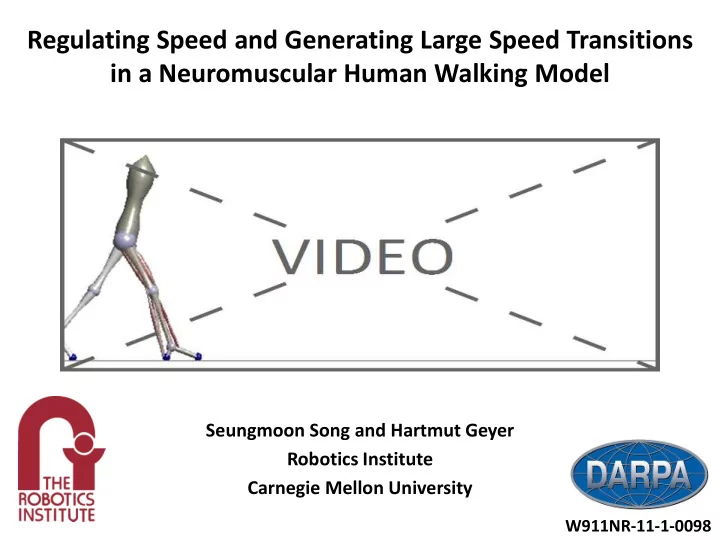

Regulating Speed and Generating Large Speed Transitions in a Neuromuscular Human Walking Model Seungmoon Song and Hartmut Geyer Robotics Institute Carnegie Mellon University W911NR-11-1-0098
Local Reflex Control Has a Large Potential for Controlling Robotic Legs CPG Reflex Humanoid vs Human Control Local Reflex Control Humanoid: HONDA (ASIMO), Boston Dynamics (PETMAN) CPG + reflex: Taga et al. (1991), Ogihara et al. (2001) Robotic ankle: iWalk BiOM 1/10
Our Reflex Based Neuromuscular Walking Model Current Limitations - Confined to the sagittal plane - Only walks at a single speed NM Model (Geyer et al., 2010), Ankle prosthesis (Eilenberg et al, 2010) 2/10
Walking Speed Adaptation of the Human Model 1. Neuromuscular Model 2. Optimization 3. Speed Adaptation
Control Groups and Underlying Principles PD trunk control Swing-leg retraction (Gunther et al., 2003) (Seyfarth et al., 2003) Knee stability (Seyfarth et al., 2001) Swing-leg Initiation (Mochon et al., 1980) Spring mass model & F+ (Geyer et al, 2003 and 2006) Left leg cycle Right leg cycle Right leg control NM Model (Geyer et al., 2010) 3/10
Walking Speed Adaptation of the Human Model 1. Neuromuscular Model 2. Optimization 3. Speed Adaptation
The Cost Function Includes Walking Speed, Energetic Cost, and Pain Target speed Energy cost Pain Cost fn. (Neptune et al., 2001) , Energy rate (Umberger, 2003) , CMA-ES (Hansen, 2006) 4/10
Walking Speed Adaptation of the Human Model 1. Neuromuscular Model 2. Optimization 3. Speed Adaptation
Optimization Results for Steady Walking Matches Human Data 0.8ms -1 1.4ms -1 1.8ms -1 v (Murray et al., 1984), C E (Minetti et al., 2001), L & f (Hirasaki et al., 1999) 5/10
Nine Control Parameters Show Strong Trend 6/10
Generation of Speed Transition: Switch Between Steady Speed Walking Controls Works for small speed transitions. Fails for large speed transitions! 7/10
Generation of Speed Transition: Explicit Transition Phase Control 8/10
Successful Generation of Speed Transition: Explicit Transition Phase Control 9/10
Conclusion We extended a local reflex based walking control to regulate walking speed and generate large speed transitions between 0.8ms -1 and 1.8ms -1 An explicit transition control was required to generate large speed transitions To walk faster the model … - leans forward - makes stronger ankle push-off - makes larger swing initiation 10/10
Recommend
More recommend